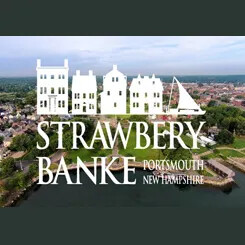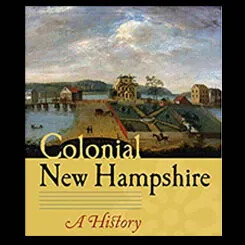Please note that a printable vocabulary list with definitions is accessible to students in the Learn It! section of this unit.
Unit Summary
The English colonization of New Hampshire in the 17th century would in many ways define the area and its people for generations to come. It was a tumultuous century that saw the arrival of the first English adventurers, bent on making fortunes from New Hampshire’s natural resources, followed by a second wave of English settlers who were hoping to pursue more modest but secure economic pursuits as farmers, merchants, fisherman, and skilled craftsmen. It was only at the end of the 17th century that New Hampshire began to unite into a single royal colony, with a governor, council, and elected legislature to coordinate the independent towns that had emerged in the region. During this same period, the Abenaki, who had lived in this area for 12,000 years, were driven off large portions of their traditional lands.
The Big Picture
During this period of English exploration and settlement, New Hampshire underwent many changes, which laid the foundation for how the region developed.
- Early European explorers to New England reported abundant natural resources, which spurred investors to establish money-making settlements in New Hampshire.
- The first four settlements in New Hampshire—Portsmouth, Dover, Exeter, and Hampton—were the primary communities in New Hampshire throughout the 17th century. Portsmouth and Dover were founded by adventurers from England hoping to make their fortunes in fish and furs. Exeter and Hampton were founded by Puritans from Massachusetts who migrated north seeking greater opportunities for wealth and more religious freedom.
- The Abenaki, devastated by an epidemic shortly before the English started arriving in substantial numbers, originally tolerated the settlers until relations disintegrated toward the end of the 17th century. By then, there were too many English settlers in New Hampshire to drive them out and instead many of the Abenaki got pushed north to French Canada or east to Maine.
- The government structure in New Hampshire was unstable until the 1710s, and at times, the four New Hampshire towns became part of Massachusetts. Throughout this period, each community in New Hampshire enjoyed almost complete political autonomy as there was seldom a colony-wide government capable of providing sustained leadership.
The Explorers
What did explorers find when they came to the area that became New Hampshire?
Just fifteen years after Christopher Columbus landed in the New World in 1492, an Italian explorer named Sebastian Cabot sailed along the New England coast in 1507 or 1508 and claimed it for the British Crown. It would be more than 100 years after that, though, before Englishmen began exploring this region in earnest.
Among the earliest explorers to New England was Martin Pring, a 23-year-old English sea captain who commanded an expedition of two ships and 44 men in 1603. The expedition was looking for sassafras, which was used as a popular medicinal treatment of the time. Pring landed in what would become Portsmouth harbor. The crew sailed up the various rivers that emptied into the harbor—the Saco, York, and Kennebunk Rivers in what is now Maine, and the Piscataqua River in New Hampshire. They failed to find sassafras, but it was the first documented landing of Europeans in New Hampshire.
Just over a decade later, another explorer, John Smith, sailed along the New Hampshire coast. Smith, who had played a significant role in founding the Jamestown colony in Virginia a few years earlier, did much to draw attention to New England. In fact, he was the one who gave the region its name. Smith’s 1614 expedition covered the New England coastline from Maine to Cape Cod, including a stop on the small islands lying off the New Hampshire shore, which he named after himself, Smith’s Isles. They later became known as the Isles of Shoals.
Pring and Smith declared this area rich in natural resources, most particularly timber and fish. Pring marveled at the dense forests filled with towering trees, and both men thought that the supply of fish might be inexhaustible. When Pring and Smith each returned to England, they wrote accounts of what they had found in the New World, emphasizing the bounty of natural resources available in the New World. They depicted New England as a place that was ripe for settlement and profitable for investment. The result was a mania in Britain for the potential opportunities on this northern coast of America.
Although Smith did not encounter any people while in New Hampshire, Pring interacted with several groups of indigenous people. By the early 1600s, an estimated 24,000 Abenaki were living in the area that would become New Hampshire, most of them located in southern New Hampshire. (See Unit 2: The Abenaki Before 1600 for more on this topic.) The coming of Europeans to their shores brought devastation to the Abenaki as they were struck by a deadly epidemic, most likely brought by European fishermen who were following the fish down the Canadian coastline from Nova Scotia. The disease itself has never been identified, but it produced a wide range of symptoms, including fever, skin lesions, hemorrhage, and jaundice. It may not have been one disease but a slew of them (chickenpox, smallpox, measles, whooping cough) to which the indigenous population simply had no immunity.
The impact of this epidemic was overwhelming. An estimated 75–90% of the people who lived within 20 miles of the coast died. Entire indigenous villages were wiped out, bringing heartbreak and disruption to the Abenaki’s traditional patterns of life, including their governance structure. Further inland, the Abenaki’s losses were less catastrophic but still severe. Although Europeans had not knowingly brought these diseases to the New World, the impact of the illnesses worked in their favor, as it cleared the New England coast, from Maine to Cape Cod, of most of the indigenous population, making way for English settlement.
The First English Settlements
Why did the first English settlers come to New Hampshire, and where did they settle?
By 1620, the English were showing a great deal of interest in the New World and hoped to plant settlements up and down the east coast. A well-connected English adventurer named Ferdinando Gorges convinced the British Crown to divide in half the Virginia colony, which encompassed all of England’s North American territory from the Carolinas up to Maine. The British Crown also chartered the Council of New England to settle this area and cultivate the region’s natural resources for profit. Gorges was the council’s first president.
Through the Council of New England, two efforts were made in regards to New Hampshire, although neither produced long-lasting profit. First, in 1623 the council awarded to an entrepreneur named David Thomson 6,000 acres in New Hampshire. Thomson established a commercial fishing operation in a settlement called Pannaway, creating the first year-round English settlement in New Hampshire. Today it is known as Odiorne Point in Rye. The small group of about 20 settlers at Pannaway built a large stone house for their protection, and they fished the Atlantic for cod, dried it, and sent it back to England, where it was sold at a substantial profit. After four years, Thomson disbanded the settlement and moved to an island in what became Boston harbor. Many of those who worked for him remained in the area, including two brothers, Edward and William Hilton, who moved inland and founded a new settlement on the Piscataqua River. They called it Hilton’s Point, but it was sometimes known by its Abenaki name Cocheco (present-day Dover).
Second, in 1629 the Council of New England granted to Colonel John Mason, former governor of Newfoundland, a huge tract of land in New Hampshire, extending from roughly the Merrimack River north along the coast to the Piscataqua River and then 60 miles inland. Mason named his territory New Hampshire, after his family seat in Hampshire, England.
Recognizing the profit to be made from New Hampshire’s natural resources, Mason first attempted a fur-trading operation called the Laconia Company, which brought nearly 100 men and women to New Hampshire, spread out over several small settlements. But the Laconia Company failed to make a profit. After it disbanded, some of its outposts were abandoned, but the group located at Strawbery Banke (present-day Portsmouth) thrived. It quickly became the largest settlement in New Hampshire as the center of fishing, timber, and fur-trading operations. Even settlers from Massachusetts began moving there, many of whom were fleeing Massachusetts’ strict religious dictates. Since most people were there to make money instead of create a religious community, New Hampshire offered far more leniency in the way people lived. Settlers built several sturdy dwellings and even constructed what was referred to as a “grand house” for Mason, who planned to journey to the New World and personally oversee his investments. Unfortunately, he died unexpectedly before his large expedition was set to depart.
Mason’s death left New Hampshire without any kind of centralized leadership. There was also a great deal of confusion about who owned the land, which discouraged investment. The Council of New England and the British government had made conflicting land grants. There was also confusion about the boundary between Massachusetts and New Hampshire, a controversy that would continue until 1740. The situation was further muddled by the arrival of more settlers to the region.
In 1638 John Wheelwright, a Puritan minister from Massachusetts, was banished by the Massachusetts government because of his independent religious views. Wheelwright and his supporters went north and founded a new settlement, which they named Exeter. Wheelwright took the unusual step of purchasing a large piece of land from the local Abenaki, complete with a written deed that the Abenaki leader Wehanownowit inscribed with his mark. The Massachusetts government refused to recognize Wheelwright’s settlement at Exeter and instead encouraged a rival group of Puritans to lay claim to land in New Hampshire at a place called Winnacunnet (present-day Hampton).
These four towns—Portsmouth, Dover, Exeter, and Hampton—would be the primary centers of population in New Hampshire until the 1720s. Especially in their early years, they were all independently governed, and there was no overarching colony-wide government. In fact, the idea of a single “New Hampshire” would have been foreign to them, and there was little that bound them together.
What were the English settlements in 17th-century New Hampshire like?
Each of the four communities evolved along different paths, but they all shared some common characteristics. Unlike the people of Massachusetts, who came to America primarily for religious reasons, the majority of the New Hampshire settlers came to the New World seeking profit, or at least economic stability. Initially, the communities they built were all geared toward making money from the area’s natural resources. Most of these entrepreneurs decided to remain in New Hampshire permanently and sought to create stable communities. In addition to emigration from England there was also a fair amount of emigration from Massachusetts, but the Puritans from the Bay Colony who ventured north tended to be slightly less religiously zealous than those who stayed behind.
Each of the four communities adopted a town-based form of governance in a model similar to that established in Massachusetts. Most men were able to participate in the democratic process. New Englanders were generally committed to the ideas of participatory democracy, believing the people should collectively make decisions, rather than having decisions imposed on them from a higher governmental authority.
The New Hampshire towns also shared a strong sense of community responsibility. There were town-based services and institutions—like churches, sawmills, gristmills, schools, and common lands—that relied on community support to function, as well as informal community policing and town-wide measures for the community’s defense from the Abenaki or the French. The town also offered aid to the elderly, widows, orphans, and anyone else from the community who required assistance. Taxes were locally imposed, which allowed voters to exercise a great deal of control over them. In addition, taxes were not generally paid in money; instead the townspeople donated their labor to a community effort, like building a meeting house or clearing a road.
Massachusetts exerted a great deal of influence on the New Hampshire towns. Towns in Massachusetts were also characterized by a strong sense of community, but they had a more hierarchical town and church structure that unified the province to some extent. Of the four New Hampshire towns, Hampton was most closely aligned with the government in Massachusetts, while Exeter and Dover had some ties to Massachusetts as well. In fact, during the middle of the 17th century, all three communities were considered part of Massachusetts, and at one point, the Massachusetts government laid claim to all of New Hampshire, designating it Norfolk County.
It was not until 1679 that the British government combined the four New Hampshire towns into the single province of New Hampshire, by which point there were roughly 2,000 English colonists living here. The decree establishing New Hampshire as a royal colony also created a structure for colonial government. New Hampshire would have a council and a president, who would effectively be the governor of the colony. The colony also had an elected legislature, known as the Assembly, which was first convened in March 1680. New Hampshire’s colonial government would be reorganized several times in the following years and not entirely free of Massachusetts for decades.
Fish, Fur, Forests
What economic ventures did the first English settlers pursue?
The settlers who came to New Hampshire during the colonial period journeyed to the New World not to escape religious persecution or political repression but to make money. For the people of New Hampshire, there were three primary ventures that promised financial success: fish, fur, and forests.
Fish. The abundance of cod in the Atlantic Ocean off the coast of New England cannot be exaggerated. Considered part of the North Atlantic fisheries, this region helped feed much of Europe beginning as early as the 12th century, when the Vikings first ventured along the coast of Newfoundland, possibly coming as far south as Maine, to fish the rich waters of the Atlantic. Even as late as the American Revolution, fishing rights in this region were of prime importance. Cod was a relatively cheap foodstuff for most people, and when dried and salted, it remained edible for long periods of time. The settlements along the coast of New Hampshire were built to take advantage of the market for cod. The cod market remained stable throughout the 17th century; it was not until the middle of the 18th century that it began to show signs of decline. New Hampshire’s inland waterways—its lakes and rivers—held huge quantities of fish as well, mostly salmon and shad.
Fur. Early New Hampshire settlers also pursued fur trapping in the 17th century. Explorers to New Hampshire had not been wrong when they reported the abundance of fur-bearing animals in the region, and a European craze for beaver pelts and beaver hats at this time encouraged fur trapping as a financial venture. Initially, settlers established relationships with the local Abenaki to trade beaver pelts for metal goods, like cooking pots, axes, and guns. The English demand for beaver was so high, though, that beavers were hunted to extinction within just a few decades, and fur-trading never produced as much revenue as investors hoped. The quest for beaver pelts led many English adventurers far into New Hampshire’s inland areas, though, which helped the English learn more about the region.
Forests. The other great industry during New Hampshire’s colonial years was the forests themselves. The explorers who visited this region all commented on the impressive forests that covered the land and the abundance of trees. The area that would become New Hampshire was heavily forested, covered with chestnut, oak, maple, birch, and most notably pine. The importance of wood products to life in the 17th and 18th centuries cannot be overstated. Wood was used to build most of the items essential for people in this period—houses, churches, meeting houses, and structures of all kinds; barrels, casks, boxes, and other containers; tools; furniture; bridges; and boats, ships, wagons, and other types of transportation. It was also the primary source of fuel, necessary to generate heat in the winter months and cook food year-round, as well as maintaining the fires needed for blacksmithing and other trades. A typical New Hampshire home required 30–40 cords of wood a year for heating and cooking.
New Hampshire settlers needed lumber to build their communities and survive, but they also needed to clear it from the land to make way for farming, which was widespread from the colony’s earliest years. In addition, New Hampshire settlers discovered a market for their lumber in Boston and the surrounding area. Some evidence shows New Hampshire supplying the Boston lumber market as early as the 1630s, and the demand only grew as more people arrived in New England. New Hampshire lumber was also shipped overseas, with the West Indies, southern Europe, and England itself being some of the colonists’ biggest markets. The combination of available lumber and Portsmouth’s sheltered harbor led to the development of a shipbuilding industry there early in New Hampshire’s history as well.
The most significant lumber trade of the colonial period was the mast trade. England and its growing navy needed tall, strong ships’ masts at an alarming rate. As navy ships grew bigger over the course of the 17th century, a ship could require more than a dozen masts, which needed to be replaced every 20 years or so. England had been deforested by 1600, so the navy was forced to look elsewhere for the trees it needed. Norway was one supplier of ships’ masts, but New Hampshire, with its towering white pine trees, became the other. White pines grew to be over 200 feet tall in New Hampshire and several feet in diameter.
Harvesting trees of this size was no easy task, though. Crews of men cut them down with axes, hauled them to the nearest river, and floated them downstream to ports like Portsmouth or Newburyport, where they were loaded onto specially made mast ships that could carry the massive trees in their holds. The work continued even in winter, with the trees being hauled by teams of oxen over the snow and ice once the rivers had frozen.
The first white pine shipment left New Hampshire in 1634, and the trade increased steadily every year thereafter. Toward the end of the 17th century, the British Crown coordinated a system to maintain a steady supply of ships’ masts. Only designated royal agents could commandeer the massive trees and profit from the trade. Furthermore, the royal agents marked each mast tree with an old navy symbol known as the king’s broad arrow to prevent English settlers from cutting down the trees and using them for their own purposes. Although a number of New Hampshire merchants and royal appointees grew rich off the mast trade, the restrictions on white pine were unpopular among the colonists, who generally ignored the rules and took the trees they wanted.
The search for white pines also encouraged the English to push into New Hampshire’s interior, eventually leading to the development of communities further inland. The role that the masting trade played in New Hampshire’s development can be seen by the prevalence of Mast Roads or Mast Streets that still exist around the state. These byways were once the paths used to transport white pines to ports so they could be used by the British navy. New Hampshire would eventually produce nearly 5,000 ships’ masts for the navy, but the masting trade became an increasing source of tension between colonists and the Crown.
Encounters
How did the arrival of the English impact the Abenaki?
The arrival of English settlers in substantial numbers dramatically changed the traditional ways of the Abenaki. Indigenous peoples had already experienced the societal disruption caused by the epidemic, which had decimated their numbers in the 1610s. By the 1620s, the Abenaki were also confronted with an ever-growing number of English adventurers, merchants, and settlers. As elsewhere in Britain’s North American colonies, the English showed little respect for indigenous society or culture.
For much of the 17th century, the Abenaki were guided by Passaconaway. He was the leader of the Penacooks, an Abenaki tribe living in the Merrimack Valley, but he also headed the most powerful indigenous confederacy in what is today northern New England. His influence extended from Lake Winnipesaukee to central Massachusetts and eastward to Piscataqua and coastal Maine. The Abenaki believed him to have mystical powers that allowed him to control the elements (such as wind and storms), transform into the shapes of animals (particularly bears), and foretell the future. He is thought to have been born sometime around 1585 and most likely lived well into the 1660s and possibly beyond. When the English began arriving in New Hampshire in the 1620s, Passaconaway urged the Abenaki to accept them and live in peace. Oral tradition claims that Passaconaway was influenced by a vision that foretold the role the English would assume in the region and that the Abenaki would fare better by welcoming them than fighting them. Such a view was also in accord with the Abenaki’s traditional beliefs of resolving conflict peaceably.
The presence of the English immediately changed the Abenaki’s way of life, as the survivors of the epidemic living along the coast were pushed off their land to make way for English settlement. The traditional pattern of Abenaki life were often disrupted by English settlers, who limited the Abenaki's access to prime fishing spots or hunting locations. The Abenaki quickly became trading partners in the remorseless English pursuit of beaver pelts. As the 17th century progressed, the Abenaki found themselves increasingly marginalized and isolated from this new society the English were establishing in New Hampshire.
Sometime around 1660, Passaconaway stepped back from his leadership role among the Abenaki and was succeeded by his son Wonalancet, who advocated the same conciliatory approach as his father had in regard to the English. However, tensions between the English and the Abenaki rose in the 1670s for a number of reasons:
- The English population had grown so large in New Hampshire that it was seriously infringing on the Abenaki, causing substantial displacement and hardship among the indigenous people.
- King Philip’s War, the major conflict in southern New England between the English and the indigenous peoples, ended early in 1676 with the almost total defeat of the Wampanoags. Refugees from that conflict moved north and joined the Abenaki in New Hampshire. Having just lost their homes and seeing their tribal structure dismantled, the Wampanoags were far less interested in peace than were the Abenaki.
- Wonalancet was succeeded by his son, Kancamagus, sometime in the late 1670s, and Kancamagus took a more aggressive attitude toward the English, possibly because he foresaw the Abenaki’s displacement from their traditional lands.
- France, Britain’s traditional enemy, had established a firm foothold in Canada (called New France) by the 1670s and embarked on a policy of harassing English settlements in the New World. The French treated the indigenous population with more respect, forging alliances with several tribes against the British. Every time relations between France and Britain broke down, the French encouraged their Abenaki allies to increase their attacks on English settlements in New England.
For all these reasons, the 1670s ushered in a period of tension and hostility between the English and the indigenous peoples in northern New England, made worse by the treachery practiced on the Abenaki and Wampanoags at Cochecho (present-day Dover) in September 1676. The Dover settlement was dominated by Richard Waldron, a merchant, trader, adventurer, and militia leader who had moved to the town in the mid-1650s. Waldron was suspicious of the indigenous population—men, women, and children—who had come to the area in the aftermath of King Philip’s War, and, at the urging of the Massachusetts legislature, he devised a plan to ship them to Boston where they could be sold into slavery in the West Indies. He organized a day of recreation for indigenous peoples in the Dover area, offering games, food and drink, and entertainment. About 350 people came to Dover to participate. Once the games were underway, armed colonists moved in and seized them. Almost all of the Native Americans were sent to Boston where efforts were made to separate the Abenaki, who were considered “friendly,” from the Wampanoag. The Abenaki were released and allowed to go on their way, but the Wampanoags were either executed or sold into slavery. The Abenaki considered the entire episode a deep betrayal of their trust and friendship.
Feeling less and less welcome in their own lands, and seeing that they were increasingly outnumbered by the English, the Abenaki began to withdraw from southern New Hampshire in the 1680s under Kancamagus’s leadership. Some went west to join Abenaki communities in what eventually became Vermont, others went north to indigenous settlements being established in Canada for all those forced out of New England by the English settlers; some went east to Maine, which had a substantially smaller English population; some Abenaki remained, living mostly in the North Country where the English had made little inroads. The Abenaki’s presence was still felt throughout New Hampshire, though, particularly as the English continued to fear Abenaki raids, which were not infrequent during these decades. The English also continued to rely on what the Abenaki had taught them about living in New Hampshire, including a greater understanding of the area’s geography, hunting and fishing techniques, and the use of the region’s natural resources.
Tensions remained high between the English and the indigenous population even after most of the Abenaki left New Hampshire, mainly because Britain and France became engaged in a protracted conflict, King William’s War, beginning in 1688. At the instigation of the French, Abenaki raiding parties from inland New Hampshire, Canada, or Maine regularly descended on English settlements in the seacoast region. The most devastating of these raids for New Hampshire occurred in July 1694, when roughly 250 Abenaki attacked part of the Durham settlement known as Oyster River. Dozens of settlers were killed, and dozens more were captured and taken for ransom. Most of the houses and structures in the Oyster River settlement were burned as the Abenaki left a six-mile path of destruction down the banks of the river. Known as the Oyster River Massacre, the attack curtailed the spread of English settlements in New Hampshire for at least a decade. Although Abenaki raiding parties from Canada remained common until the 1750s, relations between indigenous peoples and the English began to stabilize shortly after 1713 when a treaty was signed by New Hampshire’s colonial government and the Abenaki.
Conclusions
By 1720, New Hampshire had an established government and settled communities in the southeastern region of the colony, extending roughly 40 miles inland from the coast. The people of New Hampshire were fiercely independent, cherished traditions of local government, and were more concerned with economic stability than religious principles. Although some of the early industries that had characterized New Hampshire were still active, most of the colonists, especially those living inland, had embraced subsistence farming. Along the coast, fishing remained a chief occupation, and Portsmouth had emerged as the colony’s economic center with a thriving mercantile community and a shipbuilding industry.
Although New Hampshire had seen tremendous changes during this period, nearly all of its people occupied just one small region of the colony. By 1720 it was poised for a massive expansion into the Merrimack Valley and north to the Lakes Region.
Focus Questions for This Unit
Lessons in this unit are geared towards students answering the unit focus questions comprehensively through a variety of methods. This unit’s focus questions are:
-
1How were the Abenaki impacted by the arrival of the Europeans?
-
2What did explorers find when they first encountered the land?
-
3Why did the English settle New Hampshire?
-
4What was life like in the early English settlements?
Essential Questions for This Unit
Essential questions are designed to be answered repeatedly throughout the entire curriculum. This unit particularly addresses two of the curriculum’s essential questions:
-
1How has New Hampshire come to be the way it is?
-
2How has New Hampshire been shaped by many voices?
In the first two lessons of the “Settling New Hampshire” unit, students examine what the European explorers of the area found and how two cultures interacted as settlements were formed. Lessons three and four focus on how the early industries functioned and what it took to settle a town. After the fifth lesson studies the growing struggle between the English and the Abenaki, the sixth lesson, a summative assessment, guides students to show what they’ve learned by mapping the historical activity of the unit.
Lesson Plan 1: Explorers
Students identify what explorers were looking for and what they found in the land now called New Hampshire and then analyze how what the explorers brought impacted the landscape, natural resources, and indigenous people.
Lesson Plan 2: Early Industries
Students determine how the three early industries, fish, fur, and forest, worked to take natural resources and make products for England.
Lesson Plan 3: Who Owns the Land
After comparing Abenaki and European cultural perspectives on land use and ownership, students examine the Wheelwright Deed and the significance of a signature.
Lesson Plan 4: The First English Settlements
After exploring a map showing the four original settlements, students consider the community needs of a settlement and how those needs were met in a town charter.
Lesson Plan 5: Growing Conflict
Students examine how the relationship between the Abenaki and the settlers changed after Passaconaway died and the English pushed further inland and competed for resources.
Summative Assessment: Mapping the Settlement of New Hampshire
Students use a current-day map of the seacoast and add layers of data to it to show the story of exploration and early colonization of what becomes New Hampshire.
| Abenaki | (noun) Name used to refer to the indigenous people of the land now called New Hampshire |
| birch bark canoe | (noun) A lightweight boat used for travel in rivers and streams; made by stretching an outer layer of birch bark over a wooden frame |
| blacksmith forge | (noun) A building that houses the fire and tools needed to make items from iron and other heavy metals |
| brickyard | (noun) A place where clay is mixed and baked to make material for buildings |
| burying ground | (noun) An area set aside for laying to rest people who have died |
| colonist | (noun) A person living in an area governed by another, often distant, country |
| colony | (noun) An area governed by another, often distant, country |
| compass rose | (noun) A symbol that represents a compass showing cardinal and intermediate directions |
| culture | (noun) The beliefs, values, and practices learned and shared by a group of people from generation to generation |
| custom | (noun) A common way of doing things |
| deed | (noun) A signed legal document that passes ownership of property from one person to another |
| dugout canoe | (noun) A heavy boat used for fishing; made by using fire and a stone tool to hollow out the trunk of a large tree |
| expedition | (noun) A journey made by a group of people for a purpose, like exploration or research |
| explorer | (noun) A person who travels to an area unknown to them, usually in search of information or opportunity |
| extinct | (adjective) Describing a group of animals or plants with no living members |
| garrison house | (noun) A strong, defensive structure where all residents of a settlement can go for protection if necessary |
| gristmill | (noun) A building next to a river that uses water power to move large stones that grind grain into flour |
| harbor | (noun) A protected place in a body of water that is safer for ships |
| imagery | (noun) Language that describes a real or imaginary picture |
| immigrant | (noun) A person who moves from one country to live in another country |
| indigenous | (adjective) When something grows or occurs naturally in a place |
| indigenous people | (noun) The first people who lived in an area before people from other cultures arrived |
| industry | (noun) 1 Making products by using machinery and factories 2 A group of businesses that provide a particular product or service |
| inexpensive | (adjective) Describing an item that does not cost very much |
| investor | (noun) Someone who gives money to a project with the expectation they will make more money later |
| legislature | (noun) A group of people chosen or elected to make the laws for a colony or state |
| livestock | (noun) Animals that are raised on a farm, like cows, chickens, horses, and sheep |
| mast | (noun) A tall, vertical post on a sailing ship that carries the sails |
| meeting green | (noun) A large green space near the center of a settlement; animals may be pastured there |
| meeting house | (noun) A building for gathering for town meetings, worship, and school |
| merchant | (noun) Someone who buys and sells items to make money |
| natural resources | (noun) Something found in nature that is used by people, such as animals, plants, or fossil fuels |
| New World | (noun) A term used by Europeans for the Americas, especially starting in the 16th century when they were first exploring this part of the world |
| outpost | (noun) A part of a country or military that is smaller and far away from the main part |
| pandemic | (noun) A disease that has spread over a whole country or world |
| pelt | (noun) The skin of an animal, usually with fur |
| perspective | (noun) The point of view expressed through writing, speech, photographs, and other sources of information |
| preserve | (noun) To keep something so that it stays the way it was at first |
| sachem | (noun) Respected elders in a tribe who guide decision making |
| sassafras | (noun) A tree from the east coast of North America; all parts of the tree, like bark, leaves, and roots, are helpful to humans |
| sawmill | (noun) A building along a river with a machine to cut logs into timber |
| settlement | (noun) A place where people establish a community |
| settler | (noun) A person who goes to a new place to establish a community |
| shipyard | (noun) A place near a forest and a river with space to build ships |
| staple | (noun) An important element of something, especially a diet |
| subsistence farming | (noun) When a farmer grows enough food to feed their family, but not much more |
| timber | (noun) Trees that have been cut into larger beams or smaller planks to be used in construction |
| tradition | (noun) A well-known belief or custom shared by a group of people over many years |
| treaty | (noun) A legal agreement between groups that ends a conflict |
| Wampanoag | (noun) Name used to refer to the indigenous people of the land now called Massachusetts and Rhode Island |

For Students and Educators. ECHO-at-Home learning section of the ECHO Leahy Center website contains multidisciplinary examinations of topics including the “Indigenous Expressions Film Series” with short films exploring the area’s indigenous heritage (generally depicting traditions from after 1600)

For Students and Educators. Well-known, excellent museum of Portsmouth’s history from its founding to today, with increased online programming including Artifact of the Week, self-guided tours, and virtual classrooms

For Students and Educators. Historic map collection of Britain’s North American empire with document connections, inquiry worksheets, background, and teaching tips. Wider site has extensive collections, resources for educators, and connections to other website’s collections

For Students and Educators. A clear presentation of colonial history with extensive bibliography

For Educators. Lesson plan to go along with NH PBS 15-minute educational video which aired in 2010; helpful suggestions and links. Video available on website or on YouTube

For Educators. The definitive history of New Hampshire from the arrival of Europeans to the beginning of the American Revolution

For Educators. Written by a scholar of Abenaki heritage, it explores the belief system and oral traditions of the Abenaki.


